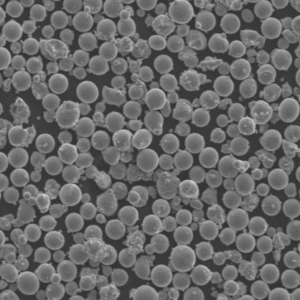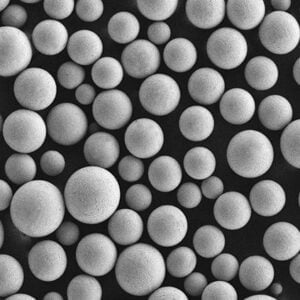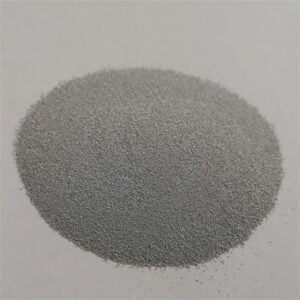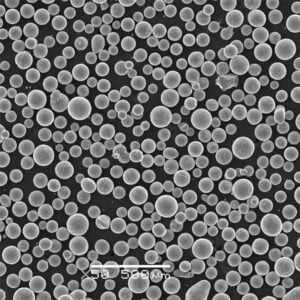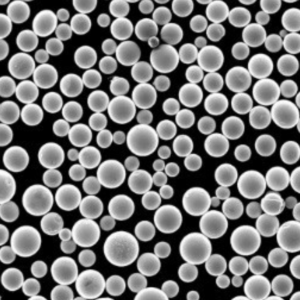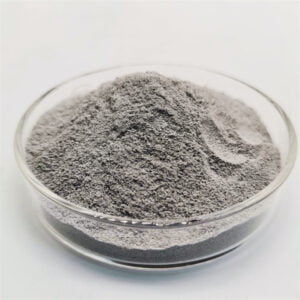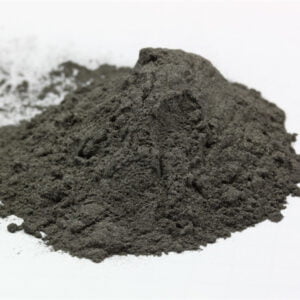球状チタン粉末の紹介
目次
球状チタン粉 チタンは、その高い強度対重量比と耐食性、生体適合性により、航空宇宙、医療、自動車、その他の要求の厳しい用途において魅力的なエンジニアリング材料となっています。その高い強度対重量比、耐食性、生体適合性により、チタンは航空宇宙、医療、自動車、その他の要求の厳しい用途において魅力的なエンジニアリング材料となっています。
本ガイドは、金属AMまたはプレス・アンド・シンター加工用の球状チタン粉末の組成、製造方法、仕様、用途、価格、および調達に関する考慮事項を網羅しています。
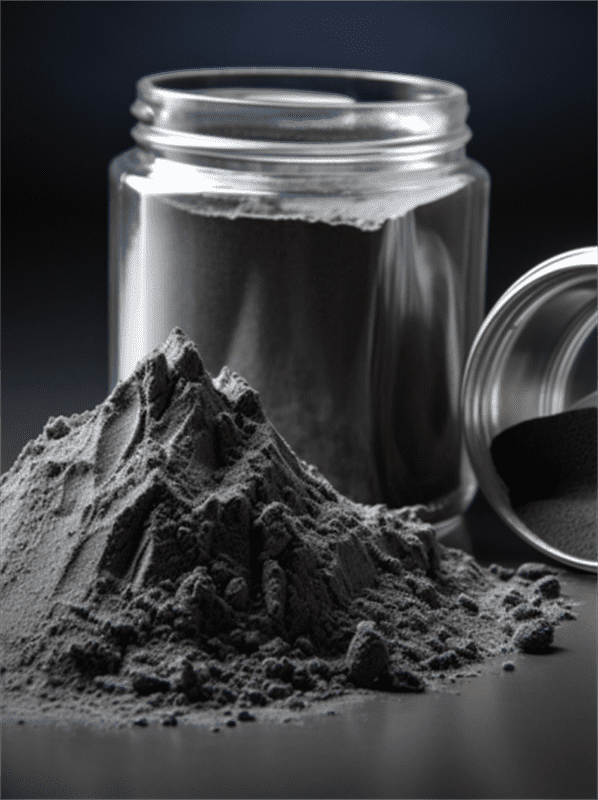
種類 球状チタン粉末の
組成と処理に基づき、球状チタン粉末は以下のように分類される:
| タイプ | 説明 |
|---|---|
| CP(商業純チタン | 99.5%以上、格子間元素不純物の少ない純チタン |
| Ti-6Al-4V | 6%のアルミニウムと4%のバナジウムを加えたチタン合金で強度を確保 |
| プレアロイ・パウダー | 均質なTi-6-4組成の固体球状粒子 |
| ブレンド・エレメンタル | 純チタン、アルミニウム、バナジウム粉末の混合物 |
機械的特性、耐食性、チタン部品用途の予算ニーズに合ったグレードをお選びください。
生産方法
- プラズマ霧化 - 高エネルギーのプラズマトーチが原料を溶融。強力な誘導コイルが液滴スプレーを生成し、チタンスフェロイドに凝固。粉体の流動性と充填密度が高く、粒子分布が最も狭い。
- ガス噴霧 - プラズマエネルギーの代わりに加圧された不活性ガスジェットを使用して、溶融チタンストリームを微細な液滴に霧化する同様のプロセス。より低出力のプロセスですが、粒子径はより大きくなります。
- 回転電極プロセス - 回転電極による遠心力で溶融チタンを液滴に分解。小さな粒子径を実現狭い分布で高速生産が可能。
温度、圧力、ガスフローなどのプロセスパラメータを制御することにより、チタン金属製造に好ましい球状の無孔質粉末を得ることができる。
構成 の 球状チタン粉
| グレード | チタン(Ti) | アルミニウム(Al) | バナジウム (V) | 鉄(Fe) | 酸素 (O) |
|---|---|---|---|---|---|
| CPグレード1 | 98.9%分 | 0.3%最大 | 最大0.2% | 0.3%最大 | 最大0.18% |
| CPグレード2 | 98.6%分 | 0.3%最大 | 最大0.1% | 0.3%最大 | 最大0.25% |
| CPグレード4 | 97.5%分 | 0.3%最大 | 最大0.1% | 最大0.5% | 最大0.40% |
| Ti-6Al-4V | ベース | 5.5-6.75% | 3.5-4.5% | 0.3%最大 | 最大0.13% |
低酸素、低窒素、炭素、鉄、クロムの制限を厳しく管理することで、耐食性と延性を維持します。グレードの選択は、様々な用途に必要な特性と合金コストのバランスを取ります。
代表的な仕様
| パラメータ | 価値 | 試験方法 |
|---|---|---|
| 純度 | >99%チタン | ASTM E2371、ICP分析 |
| 粒子形状 | 球面 >92% | 顕微鏡検査 |
| タップ密度 | 2.7-3.7 g/cc | ホール流量計 |
| 粒子径 | 15-45 μm | レーザー回折 |
| 酸素(O) | <2000ppm未満 | 不活性ガス融解 |
| 窒素(N) | <400 ppm | 不活性ガス融解 |
| 水素(H) | <150 ppm | 不活性ガス融解 |
| 流量 | 50μm用>95% | ホール流量計 |
購入前に、標準グレードの要件と、これらの測定基準にわたる一貫した性能を確認するサプライヤーからの統計バッチ証明書を確認する。
機械的特性
| 合金 | 極限引張強さ (ksi) | 降伏強さ(ksi) | エロンゲーション(%) |
|---|---|---|---|
| CPグレード1 | 130 | 120 | 20% |
| CPグレード2 | 150 | 140 | 18% |
| Ti-6Al-4V | 160 | 150 | 10% |
目標の材料強度を達成するには、熱間静水圧プレスや熱処理などの熱後加工を最適化する必要があります。グレードを必要な特性に合わせる
メタルAMアプリケーション
球状チタン粉末を使用した主要金属添加部品:
- 航空宇宙機体ブラケット、翼リブ、エンジンマウント - 高強度、軽量
- 医療・歯科: 人工股関節、人工膝関節、人工脊椎インプラント、生体適合性手術器具
- 自動車コネクティングロッド、ターボチャージャー部品-耐熱性、耐食性
- 消費者メガネフレーム、スポーツギア、時計ボディ - 美的品質
- 工業用:バルブ、ポンプなどの流体処理部品、船舶用ハードウェア、熱交換器
高い比強度を活かし、Ti6-4のような合金を、各業界の厳しい生産環境向けに調整します。
業界仕様
- ASTM F1580 - 外科インプラント用鍛造チタン6-アルミニウム4-バナジウム合金
- ASTM B348 - チタンおよびチタン合金の棒、線、粉末および鍛造用素材規格
- AMS 4999 - チタン合金粉末製造のための組成限界
- ISO 23304 - 積層造形プロセスに使用される金属粉末
統計的に検証されたバッチ証明書をレビューし、粉末ロットの品質が認証に適合していることを確認する。
品質への配慮
| メートル | 可 | 試験方法 |
|---|---|---|
| タップ密度 | ≥2.7 g/cc 以上 | ホール流量計 |
| 流量 | ≥95% 45μmふるい用 | ホール流量計 |
| 粒子形状 | ≥92%球面 | 顕微鏡検査 |
| 粒度分布 | ASTM B348による | レーザー回折 |
| 主な格子間物質(O、H、N) | <2000; <150; <400ppm。 | 不活性ガス核融合 |
粉末の品質属性は、最終的な焼結部品の材料強度、表面仕上げ、欠陥率に直接関連します。
価格帯
| グレード | 粒子径 | kgあたりの価格 |
|---|---|---|
| CPグレード1 | 15-45ミクロン | $50-$150 |
| Ti-6Al-4V | 15-45ミクロン | $55-$200 |
| Ti-6Al-4V ELI | 10~75ミクロン | $250-$750 |
価格は純度、粉末サイズ、生産量、地域要因によって異なります。お客様の用途に特化した、候補となったベンダーからしっかりとした予算見積もりを入手してください。
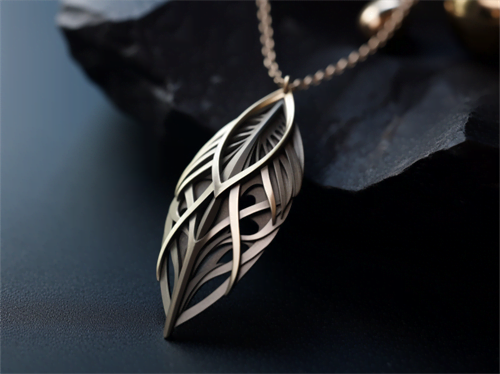
購入時の注意
| パラメータ | 重要性 |
|---|---|
| 品質認証 | 高い |
| 一貫性 | 高い |
| 部品資格データ | ミディアム |
| テクニカルサポート | ミディアム |
| サンプリング | 低い |
| 価格要因 | 低い |
よくあるご質問
Q: チタンパウダーのケーキングとは何ですか?
A: 粉末粒子が集まって部分的に焼結した凝集体をケーキングと呼びます。流動性と充填密度を妨げます。時間の経過とともにチタン粒子間のケーキングを可能にする湿気や酸素吸収の副反応を防ぐため、乾燥剤とともに密閉容器で保管してください。
Q: チタンパウダーによる健康被害はありますか?
A: ほとんどの微細金属粉末と同様に、取り扱い中の吸入は避けてください。感受性の問題を除けば、チタンパウダーは比較的不活性で無毒性であり、外部との接触や摂取事故のリスクは低いと考えられています。保管中、輸送中、加工中は適切な保護具と手順を使用してください。
Q: チタンパウダーの正しい保管方法は?
A: 酸化を防ぐため、容器はデシカントバッグで気密に密閉する。温度変化は10~30℃に抑える。水素脆化のような劣化を示す光沢のある灰色から変色した場合は廃棄する。適切に保管すれば5年以上の保存が可能。
Q: チタンパウダーは特別な輸送や取り扱いが必要ですか?
A: 非危険物、不燃物に分類される。極端な暑さや寒さの中での輸送は避ける。漏出や汚染を防ぐため、パッケージはしっかりと固定する。高純度の研究用グレードには、ゲルパック付きの特別なコールドシッパーが利用できる。
シェアする
MET3DP Technology Co., LTDは、中国青島に本社を置く積層造形ソリューションのリーディングプロバイダーです。弊社は3Dプリンティング装置と工業用途の高性能金属粉末を専門としています。
関連記事
Met3DPについて
最新情報
製品

3Dプリンティングと積層造形用金属粉末







